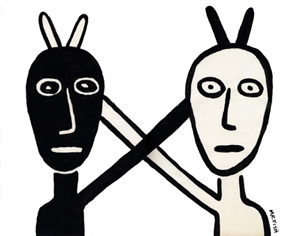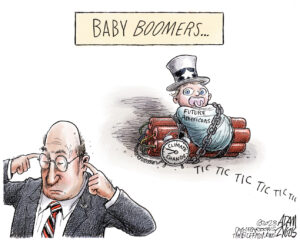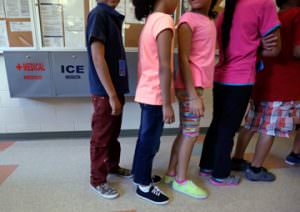Blah Blah Blah
I suddenly started to worry that the only threat hippies might pose to the dominant culture nowadays was the personal-injury lawsuits they were likely to file from accidental falls due to uneven pavement. “I’m gathering my wa,” he said, his eyes closed like he was Charlie Parker listening to the bebop rhythms of the universe, his mind awash in Gravy.
It was my habit during school dances to never stop walking. For hours I would circle the dance floor and act as if I were scanning the crowd in search of somebody. “Booth!” a classmate might yell, hoping to head me off, oftentimes with a clotheslined-arm-offering punch, and I’d hold up my index finger and push past him, craning my neck this way and that, my brow furrowed, my eyes looking everywhere in an insane pantomime of deep concentration and reconnaissance. Inevitably, the news of my solitary bug-eyed schlep around the gymnasium would be reported back to my mother, usually by my twin sister, and the assumption would be made that I was afraid of girls. I’d shrug off the simplicity of the deduction and return to my room and practice not giving a shit about what people thought, feeling like Ichabod Crane charging toward the covered bridge of my high school graduation, beyond which the Headless Horseman of Manahawkin, N.J., had no dominion over my soul.
Manahawkin, N.J.?
Inside my third-grade social studies book was a map of pre-Civil War America that showed the Mason-Dixon Line in red. I used to stare at that line and imagine it as a great bloody gash set in the body of the country by sober and learned Northerners hoping to amputate the vicious and cross-eyed hillbillies in the South from our national identity. What worried me was the irregularity of the line once it hit Delaware. Moving east with the surgical precision of a straight line along the southern border of Pennsylvania, the incision seemed to suddenly hit a bone and be redirected downward, erratically tracing around the Union’s First State and dead-ending into the sea. Anyone could see, looking at the map, that had the line been allowed to move uninterrupted it would’ve sliced through New Jersey just north of where I lived, thereby implicating me as a heehawing redneck.
Of course, had Rand McNally suddenly decided to reclassify my hometown as part of the South, little evidence would be available for me to prove otherwise. For example, the one and only black kid at my school had absolutely no friends to speak of. And while this might’ve had less to do with the color of his skin and more to do with his penchant for having seizures and wearing velour, the effect of isolation was the same. And then there were the Jackson, Miss.-like summers, which had a way of attracting prophetic significance beginning in mid-May and ending in late October, as if God were using the whole of South Jersey to rehearse an End of Days scenario for more densely populated, potentially more repentant, parts of the country.
The signs would appear overnight when one day it would be springtime, with the scent of mud and dandelions and freshly mowed grass stirring something like swarming bees inside everybody’s guts. There would be the almost audible explosion of yellow azaleas in everybody’s yard and the storybook appearance of new rabbits and butterflies and birds. Then, the next day, you’d step outside and feel as if you’d just walked down into somebody’s flooded basement. The air, heavy with pinesap, would be filled with dragonflies, grasshoppers and wasps. Green flies, as loud as incensed vibrators and as durable as seeds, would bite you through your shirt and on your face and the sun would no longer rise; instead, it would suddenly materialize at the center of the sky, swollen to the size of Jupiter, and radiate an impossible heat that seemed as unnatural as an electrical fire. At dusk, flatbed trucks would chug through the neighborhood at 5 miles per hour, lugging what appeared to be a jet engine that had been stripped of its alloy skin, revealing a deep-fried skeleton of black metal harnessed to a giant fan which belched out a great wet cloud of pesticides aimed at controlling the mosquito population by making everyone’s blood taste less like tomato juice and more like paint thinner. Midnight would bring the temperature down to 91 degrees, and moths, driven mad by the sound of a trillion chirping crickets, would trampoline their furry bodies repeatedly against your screens until daybreak, when the cycle would repeat itself.
Certainly, it is under such extreme and relentless conditions that a lifetime can be stripped of nuance and reduced to a preposterous simplicity. Often it is precisely because of those daily bombardments of discomfort and disquiet that a person will typically develop a strong reliance on the crude shorthand of prejudice and paranoia and deep rage to help explain the pain inherent is his or her victimization. Specifically, when self-preservation is made the top priority in any given situation, there is seldom room for the sort of charitable selflessness that allows a person to enjoy any peace of mind whatsoever, and without any peace of mind whatsoever a person will tend toward an active retaliation against existence itself. Consider, as a parallel, those made to endure inside prolonged cycles of poverty and war, or even those made to persevere through long prison sentences or through monotonous jobs or marriages for decades at a time.
When badgered relentlessly by exterior forces contemptuous of either personal contemplation or any opportunity for blissful complacency, a human being will seek a certain numbing comfort by shunning optimism. He will eliminate the expectation that the situation will ever improve by excising the want for it to improve if only to minimize the torture that comes with the crushing belief that his desires are inconsequential. He will then deflect blame for his situation away from himself and scapegoat others, for only a comic book character would ever assume that he alone had the power to conjure such vast and debilitating hardship. He will then do his best to champion the mediocrity of his life, typically inflating every act of non-acquiescence to complete self-annihilation into a self-delusion capable of sustaining his pride and re-imagining his existential suffocation as the hard breathing that accompanies the difficult, though heroic, job of slaying dragons.
All of this came flooding back to me, rather circuitously, during a recent trip to New York, where I had taken an assignment to interview famed altruistic hippie-clown, self-titled psychedelic relic and professional self-parody Wavy Gravy during his 75th birthday celebration at the Beacon Theatre on Broadway. Promoted as a fundraiser for the Seva Foundation, an international nonprofit health organization started in 1978 by Gravy’s best friend and former executive director of Google.org, Larry Brilliant, the concert featured David Crosby, Graham Nash, Jackson Browne, Buffy Sainte-Marie, Dr. John and Jorma Kaukonen, among others. Having been promised access to the artists backstage, many of whom were as famous for their social consciousness and commitment to compassionate hell-raising as they were for their music, I took the gig and spent the week leading up to the show trying to devise a line of questioning that might garner new insights and prompt fresh answers from these 1960s and ’70s superstars whose combined 400 years of experience in talking to reporters made me feel as if I were facing down the impossible task of looking for a suite of new notes on a grand piano without touching the keys. “Should I introduce you as Dwayne Booth or Mr. Fish?” whispered the publicist once we were about 10 feet away from Wavy Gravy’s dressing room, which would’ve been a storage closet had it contained a mop, a bucket and a 40-gallon drum of bleach instead of a Wavy Gravy in grubby Crocs and a clown nose. “Maybe I should introduce you as Mr. Fish,” she said, mentally high-fiving herself like a cheerleader suddenly overcome with the golly-gee neatness of her own cheer. “Because he has that fish on a leash, right? You know, the one he always walks around with?!”
“All right,” I said, “I’ll be Mr. Fish.”
“You don’t have a lot of time,” she said, her face quickly becoming as serious as a heart attack. “He’s trying to gather his wa before the show starts in about 15 minutes.” His wa? “Sorry about that,” she said. “I wish you had more time.” Leaning into his dressing room and spotting Gravy sitting all alone and plucking at an ektar before a large cellophaned tray of cloudy cheese and deflated fruit, his white hair exploding from beneath a filthy white bowler sporting a black propeller, I wondered if gathering one’s wa might be Japanese for coming to a quiet and dignified acceptance of one’s questionable headwear.
Of course, having been hurled like a halved mackerel into the soft purple brain bath of Wavy’s preshow meditation, it became immediately obvious to me as I closed the door and stood, struggling with my backpack to retrieve my notebook and tape recorder, my elbows pressed in close to my body as if I were undressing inside a sleeping bag, that I was an unwelcome guest. “I’m gathering my wa,” he said, his eyes closed like he was Charlie Parker listening to the bebop rhythms of the universe, his mind awash in Gravy.
“Yes,” I said, “I heard.” Eight minutes later I was back in my theater seat, having gathered my wa-the-fuck-was-that? in less time than it took me to gather, just a week earlier, all my false hopes about the political and cultural viability of a man and a movement 40 years past their prime. Rather than prompting any new conversation out of my subject, my questions merely acted as non sequiturs signaling when he should begin his rote recitation of previously published quips and poorly reasoned declarations of victory against the status quo, the singular exception being when he interrupted my last question by sighing the words “blah blah blah,” the exhaustion in his voice making me recognize him as a 300-pound Jack wanting to be returned to his box.
Then, packing up my crap and transplanting myself back into the audience and beginning what, over the next three hours, would be a series of fruitless texts with the backstage publicist for me to interview anybody else, I began focusing on the concertgoers now filing in through the gaudy and ornate archways at the back of the room. White beards and slow, shuffling steps and large wide bottoms. I watched them lowering themselves as gingerly as Easter eggs into their seats, tie-dyed and bifocaled, and I wondered, perhaps for the first time in my life, why I so constantly tried to convince myself that the Woodstock Generation was not only still an active and viable force for social and political change in America, but that it was also forever young and constantly regenerating its membership and expanding exponentially through bloodlines, like alcoholism or diabetes. Scanning the crowd and trying to find anybody under 50, I suddenly started to worry that the only threat hippies might pose to the dominant culture nowadays was the personal-injury lawsuits they were likely to file from accidental falls due to uneven pavement.
After all, here were people dressed in the universally accepted uniform of the beloved peacenik, nearly all of them, yet none of them seemed so much peaceful as sleepy. It seemed as if their uniforms, after decades of insular overuse, had become mere costumes designed to reflect the quaint nostalgia of an earlier era that was no more relevant to the present day than winklepickers, culottes or powdered wigs. Had not the peace sign itself finally become as trite and ineffective as the Live long and prosper hand sign popular at “Star Trek” conventions? With the same scant knowledge possessed by the average Trekker as to what it might mean to engineer and then pilot a vehicle capable of intergalactic travel, I imagined that there was nobody around me who might have the slightest idea as to what it meant to engineer a social movement and then to pilot it in the direction of Donovan’s “Atlantis.”
Sure, I thought, tonight’s performance was guaranteed to provide the Seva Foundation, particularly the organization’s Sight Programs, with a sizable chunk of change, thereby helping to bring the gift of sight to millions living in Tibet, Nepal, Cambodia and Bangladesh and throughout Africa, but — and here’s the point — what else? It was as if I were surrounded by enthusiasts for alternative fuel who had convinced themselves that they were good guys because they knew that if everybody in the country went green starting tomorrow, in 20 years’ time the United States would be a brutally fascistic plutocracy capable of sustaining itself exclusively on corn oil and windmills. In other words, by hijacking the music and the imagery of 1960s anti-establishmentarianism and forcing it to mellow along with its creators, the originators of flower power and free love had, I feared, unwittingly become the antithesis of the struggle itself, and by defanging the snake of radicalism so that everybody could safely hold it, the rats who used to constitute the predator’s main diet were now running rampant. After all, here was Wavy Gravy — a man who at one time was such a threat to state power and straight society that he had to endure frequent beatings by riot police and who had been continuously praised by real revolutionaries — now voting for Barack Obama and rejoicing in the greater celebrity that he enjoyed as the namesake of a discontinued ice cream.
Leaving the Beacon Theatre that night and heading up Broadway with my “All access” press pass still strung around my neck, I figured that the news of my solitary bug-eyed schlep along the periphery of everybody else’s communal optimism during the show would be reported back to my editor, most likely by the column that I planned to file, and that the assumption would be made that I was afraid of harmless do-gooders who believed that compassion and joy and togetherness was enough to save us all from self-annihilation.
Sadly, the assumption would be true.
Your support matters…Independent journalism is under threat and overshadowed by heavily funded mainstream media.
You can help level the playing field. Become a member.
Your tax-deductible contribution keeps us digging beneath the headlines to give you thought-provoking, investigative reporting and analysis that unearths what's really happening- without compromise.
Give today to support our courageous, independent journalists.






You need to be a supporter to comment.
There are currently no responses to this article.
Be the first to respond.